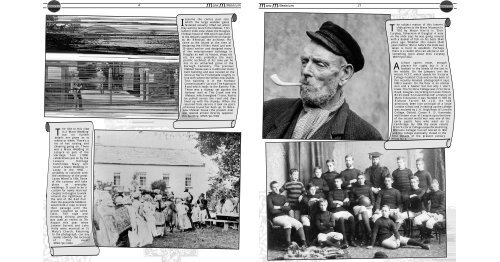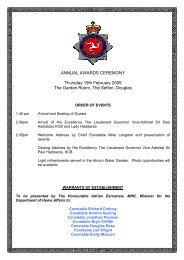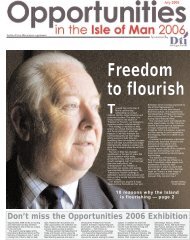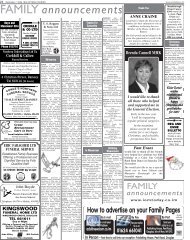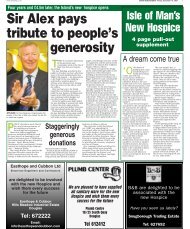m - Isle of Man Today
m - Isle of Man Today
m - Isle of Man Today
Create successful ePaper yourself
Turn your PDF publications into a flip-book with our unique Google optimized e-Paper software.
m<br />
4 anxmillennium<br />
manx illennium<br />
21<br />
m<br />
The title to this view<br />
is a ‘<strong>Man</strong>x Wedding’<br />
but no further<br />
details are given as to<br />
where or when. There’s a<br />
lot <strong>of</strong> hat raising and<br />
cheering going on. There<br />
was a <strong>Man</strong>x Wedding at<br />
Lezayre as part <strong>of</strong> the<br />
Heritage Year (1986)<br />
celebrations put on by the<br />
Lezayre Heritage<br />
Committee. <strong>Man</strong>y will<br />
recall a <strong>Man</strong>x Wedding in<br />
Laxey in the 1950s –<br />
probably to coincide with<br />
the centenary <strong>of</strong> the great<br />
Laxey Wheel in 1954. Some<br />
<strong>of</strong> the customs still take<br />
place at everyday<br />
weddings. It used to be a<br />
custom for newly married<br />
couples in Douglas to walk<br />
around the lighthouse at<br />
the end <strong>of</strong> the Red Pier<br />
then the quayside hobblers<br />
would hold a rope to block<br />
their passage until the<br />
groom coughed up some<br />
coins. The rope and<br />
throwing shining pennies<br />
was used as recent as 7th<br />
August this year when<br />
Joanne Garrett and John<br />
Kelly were married at St<br />
Mary’s Church. Returning<br />
to the photograph, can any<br />
reader identify the location<br />
<strong>of</strong> this event?<br />
MNH/pic/4324<br />
Iassume the centre post into<br />
which the large wooden gates<br />
fastened actually lifted out when<br />
they went to launch the lifeboat. This<br />
lantern slide view shows the Douglas<br />
lifeboat house <strong>of</strong> 1896 which was built<br />
to the designs supplied free <strong>of</strong> charge<br />
by Mr Rennison the architect. He<br />
came to the Island at the time <strong>of</strong><br />
designing the Villiers Hotel just over<br />
20 years earlier and designed many<br />
<strong>of</strong> the entertainment buildings in<br />
Douglas as well as houses, shops etc<br />
etc. He was probabl;y the most<br />
prolific architect <strong>of</strong> his time yet he<br />
lies in an unmarked grave in the<br />
Borough Cemetery. The previous<br />
lifeboat house was a traditional stone<br />
built building and was located on the<br />
shore at Harris Promenade roughly in<br />
line with where the Sefton now stands.<br />
This building is in the Harbour<br />
Commissioners’ yard on The Approach<br />
Road which leads to the Battery Pier.<br />
There was a slipway set against the<br />
harbour wall at The Croak and the<br />
lifeboat, which weighed 11 tons, had to<br />
be pulled across the road and then<br />
lined up with the slipway. When she<br />
returned from service it took six pairs<br />
<strong>of</strong> horses to pull her back up. In 1924 a<br />
new lifeboat house (the present one)<br />
was opened almost directly opposite<br />
this building. MNH/pic/1002<br />
The subject matter <strong>of</strong> this lantern<br />
slide given to the <strong>Man</strong>x Museum in<br />
1952 by Major Harris is ‘Dick<br />
Curphey, fisherman <strong>of</strong> Douglas’ A note<br />
on the slide says he was going around<br />
with a basket <strong>of</strong> fish on his back 30-40<br />
years ago. Whether this meant 30-40<br />
years before 1952 or before the slide was<br />
taken is hard to establish. Perhaps<br />
there is a reader who can advise or tell<br />
something more about Dick Curphey<br />
MNH/pic/4222.<br />
Aschool sports team, enough<br />
players for rugby but it is a<br />
football in the hands <strong>of</strong> the lad in<br />
the middle. On the jumpers are the<br />
initials VCFC which stands for Victoria<br />
College Football Club and on the back <strong>of</strong><br />
this recently donated photograph it says<br />
1882-3 season. On the floor is an animal<br />
skin and a bowler hat but why I don’t<br />
know. The Victoria College was in Victoria<br />
Road, Douglas. According to Canon Hinton<br />
Bird’s book ‘An Island that led’ a history <strong>of</strong><br />
<strong>Man</strong>x Education it was founded in 1881 by<br />
Richard Farrell BA LLD. He had<br />
previously been vice principal <strong>of</strong> a large<br />
London school and in setting up the college<br />
was assisted by J.H. Hopkinson <strong>of</strong> Lincoln<br />
College, Oxford. Canon R. D. Kermode,<br />
well known vicar <strong>of</strong> Lezayre up to the time<br />
<strong>of</strong> the second world war was one <strong>of</strong> the<br />
early pupils here who went on to<br />
Cambridge. By 1884 the exam results<br />
from Victoria College outperformed King<br />
Williams College! Farrell retired in 1892<br />
and the college eventually closed in the<br />
first decade <strong>of</strong> the present century<br />
Photo No 4.


